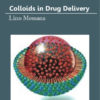Polymers that can degrade into biologically compatible components under physiologic conditions are advantageous for the preparation of drug delivery systems (DDS). The use of biodegradable polymers precludes the need for retrieval at the conclusion of the dosing regimen, thereby avoiding the potential complications associated with the use of non-degradable systems. Homopoly – mers and copolymers, obtained from glycolide, lactide and -caprolactone and trimethylene carbonate (TMC), are the most commonly considered drug delivery vehicles. However, there are still few implantable drug delivery systems obtained from biodegradable polymers.
Attachment of drugs to high molecular weight polymers can significantly improve both tumor targeting and therapeutic efficacy due to the enhanced permeability and retention effect observed in tumor tissue. However, the commercial availability of well-defined water-soluble polymeric systems with narrow polydispersities that are biocompatible, nontoxic, and nonimmunogenic is rather limited. Even with the progress of novel materials, polyesters still endure at the controls of drug delivery technologies.
Handbook of Polyester Drug Delivery Systems provides comprehensive information of polyester drug delivery systems that covers a wide-ranging of materials design, manufacturing techniques, and applications.
Polyglycolide (PGA) was one of the first biodegradable synthetic polymers investigated for biomedical applications and was synthesized for the first time in 1954. In the beginning, it was not considered for biomedical applications because of its thermal and hydrolytic instability. However, the ability to degrade inside the human body became a great advantage.













